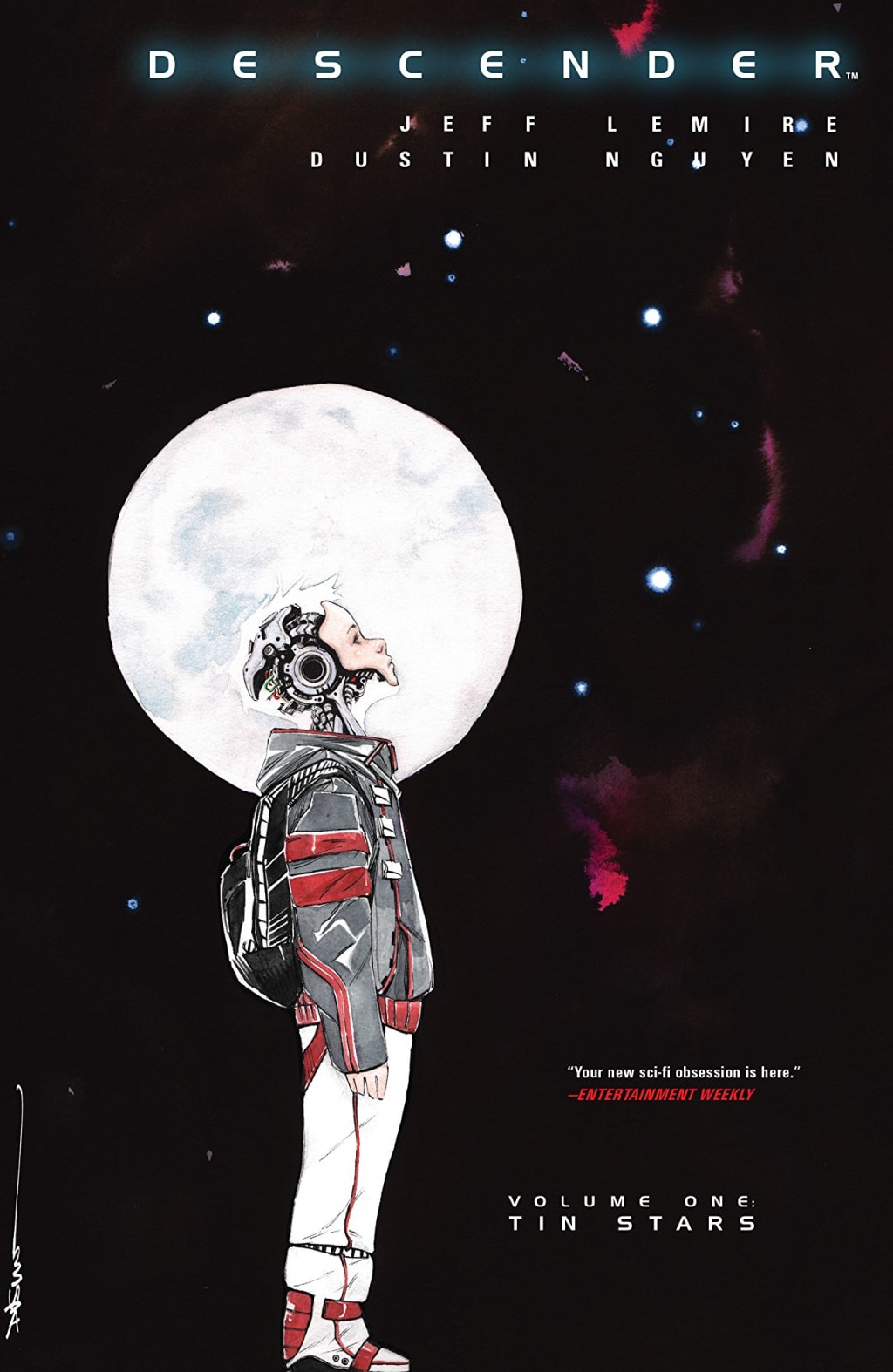Review: 'Descender Volume One: Tin Stars'
Sci-fi Comic Series by Jeff Lemire and Dustin Nguyen

-Non-Spoiler Section-
Descender succeeds in taking an overdone concept, robots turning on humans, and creating a beautiful story that is told as much through it's minimalist watercolors as through the writing. The universe Lemire creates feels fresh and original and is teeming with story opportunities. Early on you recognize that the robots take on a fantasy level realism. The characters all have defined and conflicted personalities. It all comes down to how the art sets the mood and narrative choices make the plot feel fresh.
Descender is an ongoing series by writer Jeff Lemire and illustrator Daniel Nguyen. I am not familiar with Nguyen’s previous work and watercolors in comics can be hit or miss, but they definitely succeed in this story. Watercolor is best when the storytellers seek to convey dreamy atmosphere where the artist foregoes detail for mood. It’s a weird choice for a story that involves so much tech, but somehow Nguyen manages to work the right amount of detail in when necessary. A good example of tech detail is the cover of the trade paperback pictured above. There is a high use of white and complete emptiness in some cases that creates a strange setting. The best example is when characters are in space ships or laboratories. That empty feeling goes a long way when it gets contrasted with outside where skylines are different shades of pink and blue. Without Nguyen, this comic would have a completely different mood.
-Spoiler Section-
Jeff Lemire tells Descender’s story through a series of flashbacks mixed with the main narrative being told in the world’s present. Giant space robots appeared in orbit of the main planets of the United Galactic Council. Those giant space robots attacked the UGC, killing millions across known civilization and creating anti-robot hysteria and an ongoing ten year robot culling where being scrapper, finding and destroying robots hiding in different parts of the galaxy, is a viable career.
Lemire introduces us to many different locales in volume one. The worlds he created were exciting, jumping from a mining moon, to the hub of the UGC planet Niyrata, to the luddite world of Gnish and the empty world Ostrakon with ruins of an advanced ancient civilization. Not only because the story I was reading was engaging, but also because of the potential these imaginative planets and their inhabitants have for future stories.
The thrust of the story is about Tim-21. Tim-21 is a robot trying to find his human brother; also returning to a galaxy that hates robots. There will always be opportunities for political subplots like Gnish and the UGC going to war, countless scrapper stories, and even self-contained stories on places like the planet Phages where the cities and occupants are all made of gas.
The characters have their own subtle complexities. Finding out Dr. Quon’s embarrassing history and about Captain Telsa and her family/political relationships are just a few of the layers of history and characterization that we get introduced to in the first volume.
One liberty the writing takes is the level of sentience the robots have, despite nothing in the narrative about them being sentient. Basically, they act like they do (like emotive humans) through machine learning. Even robots considered dumb like the Drillbot have feelings and make strange human-like decisions. This is for the best, because in the end this is a story driven by the characters. It feels as if it is immoral to scrap robots, it feels like murder, but they are supposed to be just robots, they’re never considered sentient intelligence.
World building is one of the buzz words people are starting to use negatively, but it describes another aspect that made these first issues of Descender great. Within six issues, we have a lot of groups that stand against one another. The Gnish are the antagonists on a political level. If there were no robots to deal with they would be the evil military planet. The scrappers have a Star Wars bounty hunter feel, the UGC is a political group of planets that surely means well, but any bureaucracy will have its issues. There is the robot liberation group, Hardwire, that only gets a cameo, but is sure to feature in subsequent issues. That’s not including all the individual cultures that are within the UGC that have their own functions.
The book overall is exciting and thought provoking and even though it isn’t always necessary in comics, when an artist drives the story as much as the letters on the page, we get to experience what makes the comic book medium special.
About the Creator
Christopher Sarda
Leader of men. Drinker of beer. Reader of words. Learner of stuff.
twitter.com/chrissarda






Comments
There are no comments for this story
Be the first to respond and start the conversation.